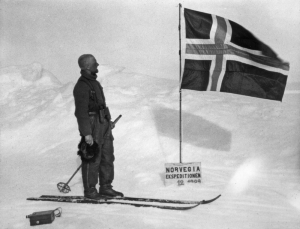Did you know that airplanes played a crucial role in Norwegian mapping of Antarctica?
Norwegian pilots were pioneers in Antarctica; they flew over vast areas taking photographs so it would be possible to construct maps based on aerial photography.
 Finn Lützow-Holm at Enderby Land in Antarctica. Photo: Norwegian Polar Institute
Finn Lützow-Holm at Enderby Land in Antarctica. Photo: Norwegian Polar Institute
Hjalmar Riiser-Larsen had accompanied Amundsen to the North Pole as navigator and second-in-command, and was in charge of Lars Christensen’s third expedition with Norvegia to the Southern Ocean. The pilot Finn Lützow-Holm also went along. Using aerial photography, the expedition charted huge tracts of land between Enderby Land and the Weddell Sea. It is precisely this area that now goes by the name of Dronning Maud Land.
The shipping magnate Christensen financed an entire series of expeditions to Antarctica. The last of these was onboard the tanker Torshavn in the 1936–37 season. The commission for aerial surveying during the expedition had gone to Widerøe’s Flyveselskap, and Viggo Widerøe himself went along as pilot. With him he brought his wife Solveig, the photographer and radio technician Nils Romnæs and two mechanics, Tom Fidjeland and Hans Strandrud. In addition, the photography expert Erik Simensen went along to develop and check the aerial photographs. An aircraft was leased for the purpose: a Stinson Reliant, 1936 model, with a 350 horsepower engine and an action radius of 1 200 km when fitted with an extra fuel tank. The plane was constructed to be able to land and take off again on short runways, and was outfitted with modern short- and long-wave radio that enabled two-way communication.
They did photogrammetric surveying, in which a camera mounted under the aircraft automatically takes oblique images of the terrain. The camera took stereographic images: two photographs were taken simultaneously with a 60 percent overlap. These photographs could later be examined stereoscopically in a cartographic apparatus called a stereoplotter. In this way, cartographers could view a three-dimensional image of an area and reconstruct contour lines, giving an accurate representation of the landscape in the form of a contour map. The same technique was used during the expedition to Greenland in 1932 and in Svalbard in 1936.
When Norway annexed Dronning Maud Land in 1938, the geographic mapping work done from airplanes was accorded great importance. Norway’s argument was that the area was no longer terra nullius, even if no-one had gone ashore there; Christensen’s many expeditions to the area along with the extensive whaling activity was sufficient cause.